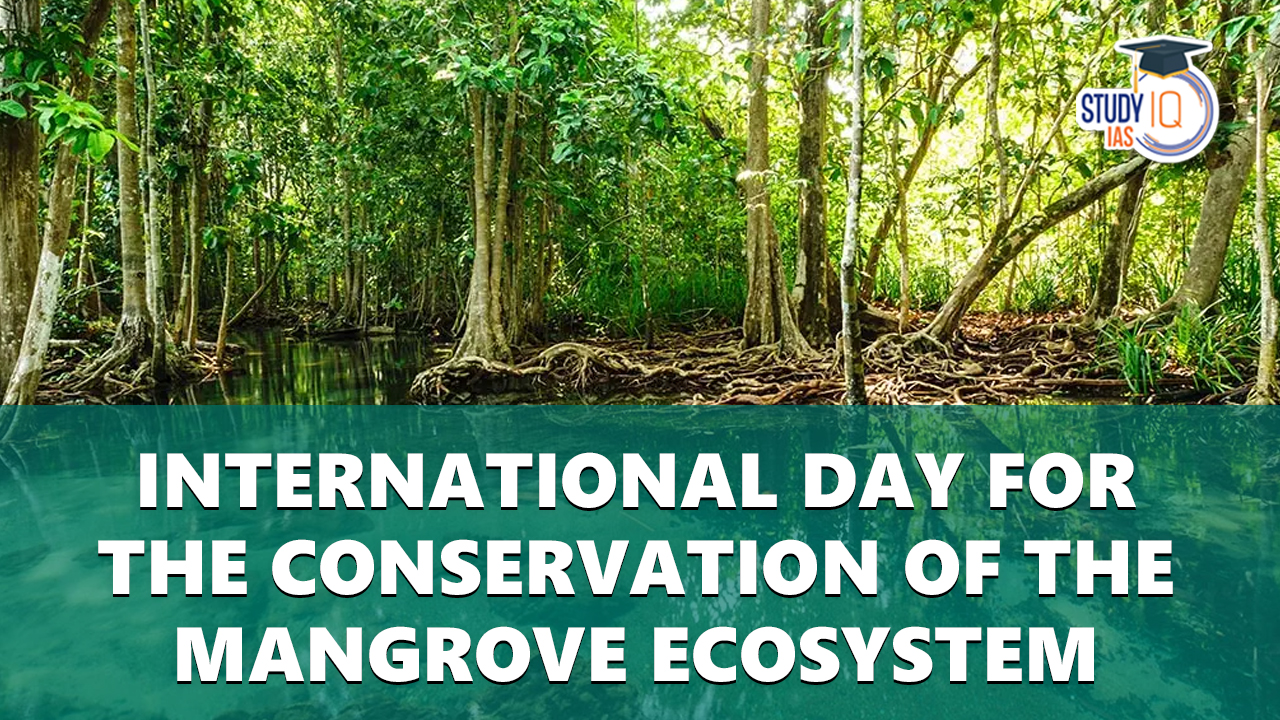Table of Contents
International Day for the Conservation of the Mangrove Ecosystem
Every year on July 26th, the world celebrates the International Day for the Conservation of the Mangrove Ecosystem. Its goal is to raise awareness of the value of mangrove ecosystems as distinctive, priceless, and vulnerable environments around the world. The day also aims to promote sustainable methods for maintaining, protecting, and using natural ecosystems. This International Day was formally established by the UNESCO General Conference in 2015.
International Day for the Conservation of the Mangrove Ecosystem 2023
On July 26, there will be a celebration of the International Day for the Conservation of the Mangrove Ecosystem. The General Conference of the UN Educational, Scientific, and Cultural Organisation (UNESCO) authorised this yearly observance in 2015.
| Event Name | International Day for the Conservation of the Mangrove Ecosystem |
| Celebrated | 26th July (every year) |
| Established By | UNESCO |
| Aim | To raise awareness about the significance of mangroves. |
International Day for the Conservation of the Mangrove Ecosystem 2023 Theme
The overall goal of the International Day for the Conservation of the Mangrove Ecosystem 2023 is to mobilise people to call for the preservation and restoration of mangroves throughout the world. Other than that, there isn’t a particular theme determined for this yearly event.
International Day for the Conservation of the Mangrove Ecosystem Inception
The official first World Mangrove Day took place on July 26, 2016. As a result of Ecuador’s request, the UN Educational, Scientific and Cultural Organisation (UNESCO) officially proclaimed 26 July of each year as the International Day of the Conservation of the Mangrove Ecosystem on 6 November 2015 during its 38th session of the General Conference in Paris. This was done through resolution 38C/66. It is sometimes referred to as World Mangrove Day.
The day was chosen to honour Greenpeace activist Hayhow Daniel Nanoto, who passed away on July 26, 1998, while participating in a sizable demonstration to restore the mangrove wetlands in Muisne, Ecuador. Nanoto died of a heart attack.
International Day for the Conservation of the Mangrove Ecosystem Significance
Mangroves play a significant role in the protection, well-being, and food security of coastal populations all over the world. They provide assistance to the diverse wildlife, including fish and crabs. They serve as a defence against storm surges, erosion, tsunamis, and rising sea levels. Additionally, they serve as barriers between the sea and land and offer various coastal towns security and protection. As carbon sinks, the mangrove ecosystem’s soils can store ten times more carbon than forests on land can.
The Global Mangrove Alliance (GMA) is a group of organisations that have united to advocate large-scale mangrove protection, restoration, and sustainable use. In order to stop mangrove degradation and expand mangrove cover by 20% by 2030, this coalition brings together NGOs, governments, businesses, and local people.
World Mangrove Day serves as a reminder of how important mangroves are to maintaining ecosystems. Since 2015, various parties, non-governmental organisations, and interested parties have observed this day on July 26 each year with outreach initiatives around the world to raise awareness of the need for international cooperation to protect the mangrove ecosystem and to advance creative solutions for their sustainable management, conservation, and use. The International Day of the Conservation of the Mangrove Ecosystem does not have an annual topic, unlike other international holidays.
International Day for the Conservation of the Mangrove Ecosystem History
In order to raise awareness of the crucial importance of mangrove ecosystems, UNESCO established the International Day for the Conservation of the Mangrove Ecosystem, which is celebrated on July 26. Promoting the preservation and sustainable development of mangrove forests is the primary goal of this day.
The complicated root systems of mangrove forests act as protected nurseries for a variety of creatures, sheltering them from predators, high heat, and strong tides. Mangrove forests are therefore of great ecological significance. Additionally, compared to terrestrial forests, these coastal forests are extremely successful in removing five times more carbon dioxide from the atmosphere.
The size of mangrove forests has sadly decreased by about half over the past 40 years as a result of numerous dangers. Shrimp farming, in which enormous areas of the forest are removed to make enclosed ponds for shrimp breeding, poses the most risk. The excessive use of antibiotics and pesticides in this method of crop improvement and disease prevention causes irreparable harm to the natural balance of the forests.
Additionally, there is significant deforestation due to the frequent exploitation of these woods’ prized timber, which is sold for high profits and used to produce charcoal. The environment for mangroves is further harmed by the development of roads, buildings, and the diversion of rivers for irrigation, especially when the majority of mangrove forests are found on estuaries.


 UPSC CDS 1 Final Result 2025 Declared: D...
UPSC CDS 1 Final Result 2025 Declared: D...
 UPSC EPFO Result 2025 Out: EO/AO and APF...
UPSC EPFO Result 2025 Out: EO/AO and APF...
 UPSC CSE Interview Schedule 2025: Dates,...
UPSC CSE Interview Schedule 2025: Dates,...

























